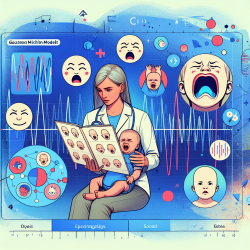Understanding Infant Cries: A New Frontier in Pathology Classification
In the world of speech-language pathology, infant cries are more than just sounds—they are a potential diagnostic tool. Recent research has shed light on how these cries can be used to classify pathologies, offering a non-invasive method to identify health issues in newborns. This blog explores the findings from the study titled Cry-based infant pathology classification using GMMs and how practitioners can leverage these insights to enhance their practice.
The Power of Cry Analysis
Infant cries are the earliest form of communication, and their acoustic features can reveal a lot about a newborn's health. The study utilizes Gaussian Mixture Models (GMMs) to analyze the acoustic properties of cries, distinguishing between healthy and pathological conditions. By focusing on both expiratory and inspiratory cry sounds, the research presents a comprehensive approach to cry analysis.
Key Findings and Implications
- Acoustic Features: The study identifies specific cry characteristics that differ between healthy and sick infants, such as variations in Mel-Frequency Cepstral Coefficients (MFCCs).
- Classification Accuracy: The adapted Boosting Mixture Learning (BML) method showed lower error rates compared to traditional Bayesian approaches, making it a reliable tool for early diagnosis.
- Non-Invasive Diagnosis: This method offers a non-invasive alternative for early detection of conditions like neurological disorders, potentially improving infant care in both developed and developing countries.
Implementing the Research in Practice
For practitioners, integrating cry analysis into routine screenings could revolutionize early diagnosis. By adopting the GMM-UBM framework, speech-language pathologists can enhance their diagnostic capabilities. This approach not only aids in identifying pathologies early but also supports data-driven decision-making, ensuring that interventions are timely and effective.
Encouraging Further Research
While this study provides a solid foundation, further research is necessary to refine these methods and expand their applicability. Practitioners are encouraged to collaborate with researchers to explore additional acoustic features and improve classification models. By doing so, the field can continue to advance, ultimately leading to better outcomes for infants worldwide.
To read the original research paper, please follow this link: Cry-based infant pathology classification using GMMs.










